 VC Blog | Contact
VC Blog | ContactVOLSCAN - The First Computer with a Desktop Graphical User Interface (GUI)?
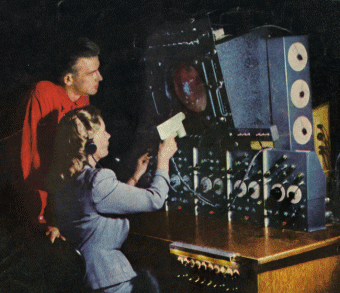
A while back I picked up a copy of the July 1954 Radio-Electronics because the cover depicted what appeared to be a very early computer with a table-top light gun input device. The Volscan console was equipped with a light gun that served as the interface for selecting objects (aircraft) for the computer to perform its calculations (telemetry/velocity management). Could the Volscan console be considered a desktop computer? Perhaps not, but it could be argued that the Volscan console and light gun together served as a "desktop" graphical user interface. The other major components of Volscan was the Antac and the Datac, described below.
I believe that the Volscan Computer is an off-shoot of the earlier MIT Whirlwind project, but I do not have enough information yet to confirm this connection.
Could the Volscan console and light gun be the first desktop GUI to a computer? Click here to enter your comments. Below is a transcript of the entire article with pictures.
Volscan Speeds Up Air Traffic
By Angie PascaleWhen a large number of military aircraft return to a base within a short time, a terrific air traffic control problem is set up. The problem becomes greater when we consider that more and more jets are being used. They have to be landed as quickly as possible because the lower they fly, the more fuel they use. Therefore, if the landing operation takes too long, the jets can very easily run out of fuel and crash. No human being can control more than 40 planes an hour. The problem was how to land 120 planes or more an hour. It was solved with the Volscan Air Traffic Control System, developed under Ben F. Green, Air Force Cambridge Research Center.
Volscan Closed-loop System
To control 120 aircraft an hour Volscan uses two identical Traffic Operator Consoles and one Monitor Console. The Traffic Operators use a common radio channel to answer incoming aircraft. Each console has a PPI scope a panel controlling seven Antrac-Datac channels, and a Volscan Light Gun for assigning Antracs (Auto-matic tracking-while-scanning).
The Monitor's PPI permits him to watch the progress of all controlled aircraft. His time-situation panel shows the type and scheduled arrival time of each aircraft. Push-buttons permit him to change their automatically assigned schedules or to reserve time in the future for take-off's. The control for setting in the wind direction and velocity and entry gate locations are also on his panel.
Volscan Data Flow Diagram
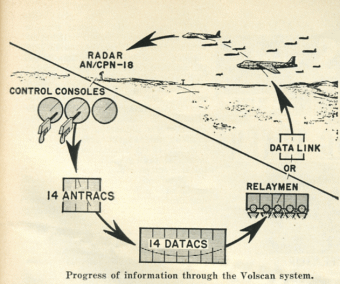
Click Image for larger version
Antrac
An Antrac is assigned to the radar target by pointing the Volscan Light Gun at the corresponding blip on the PPI. When the light gun is pointed at a signal on the PPI, the light from that signal alone enters the barrel, thus effecting a time coincidence which moves the tracking gate to the position on the scope at while the gun is pointed. Once the Antrac is assigned, it isolates the target from all others by throwing a "gate" around it. Since the gate moves, following the blip, the Antrac retains the identity of the target.
An Antrac sort out the data on a specific aircraft by generating two electronic time gates, one representing the predicted range of the aircraft plus an minus the gate width, and the other having the same function for azimuth. Since it is required that an incoming radar echo coincide with both these gates to enter an Antrac, each Antrac received video signals from only aircraft that are within the area of space defined by the coincided range-azimuth gates. When a new echo from the aircraft does enter the Antrac, the error between the gate position and the echo is measured electronically and is utilized to correct the gate';s position and velocity. which are then stored for use until the next echo is received.
As the Antrac, in period of several scans, acquires the velocity of the target, it smoothes the periodic video pulses that are in the input into a gradually changing d.c. output. By holding the target velocity in its memory, the Antrac predicts where the target is during radar fades by continuing to move at the last rate it had memorized. The young lady of the cover has placed four gates on the PPI scope. The Antrac continuously reports to the computer the exact positions of the four targets.
Datac Schedule Computer

Click Image for larger version
A channel of the Volscan computer is called Datac, automatically selects a scheduled arrival time for the aircraft and calculates heading and altitude orders which will make good this schedule.
Datac calculates the aircraft's direct flight time over the shortest possible path, which is the tangent path to the final turn circle. It reserves the earliest possible scheduled arrival time which the aircraft can make without conflict with other inbound traffic.
Throughout the run, Datac computes an error ratio which indicates the aircraft's performance in related to its schedule. If the aircraft is on time, Datac orders a heading which directs it along the tangent path at present velocity. If the aircraft is late, Datac orders a heading which will hold it on the tangent path and increase velocity. If the aircraft is early, Datac orders an offset heading proportional to the magnitude of the error ratio so that the aircraft will be delayed sufficiently to meet its schedule.
Datac does not predict a fixed path for the aircraft, but is always calculating to see what heading it should fly to make good its schedule. It controls the descent of the aircraft so that it will reach the entry gate at correct altitude.
The Datac control orders are relayed to the aircraft by voice or are sent automatically over the Data Link for display on the Zero Reader or for injection into the aircraft's autopilot. As the plane responds to the control orders, the radar reports the change in its position, thus completing the loop.
The tracking and computing equipment making up the Volscan can be utilized in building-block fashion to meet the needs of any particular installation. For instance, if the traffic rate at a base increases, one additional console and seven additional channels can be added.
One Volscan channel contains only 60 tubes. Since a Volscan airbase installation consists principally of a number of such channels, it is not necessary to provide spares; each is a spare for the others.
Volscan can deliver aircraft satisfactorily to terminal points as far away as 20 miles, with some reduction in traffic rate, and as close as 2 miles, with no reduction in rate.
On the Work Bench - Oct 2006
These are some of the computers that I am currently working on, or have recently picked up. Check my Vintage Computer Blog for updates, or post your questions.Altair 8800
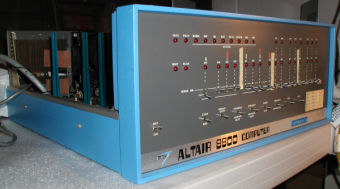
Click Image for larger version
NOTE: This is one of two similar 8800's I have recently acquired.
Malvern Particle Sizer
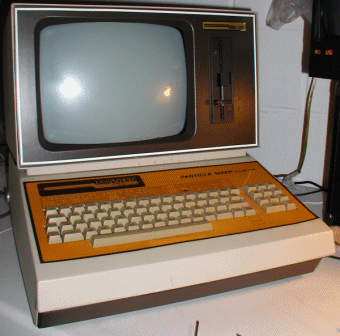
Click Image for larger version
NOTE: This is an OEM Commodore 8296 computer with customized components. See Blog and more pics
Ken's Number Cruncher

Click Image for larger version
This is a Homebrew 6502 processor-based S-100 bus KIM expansion chassis! Related Blog and pics
California Computer Systems Series 2200

Click Image for larger version
Jade Z-80 Processor. Related Blog and pics
Classic Computing Items for Sale:
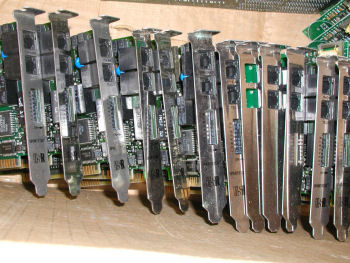
| CBM Commodore B Series Software (B-128 / CBM 700) | ||
| Superscript II Word Processor | $29.99 | |
| Superbase Database Manager | $29.99 | |
| Commodore Advanced Business Systems (CABS) Acccounting Suite: Accounts Payable, Order Entry, Accounts Receivable, General Ledger (4 binders) | $29.99 | |
| More CBM Commodore Items | ||
| Commodore B-128/700 Programmer's Reference Guide - Protecto - Everything you need to know about the B line! | SOLD OUT | |
| B Series Commodore Users Guide - View Image | $39.99 | |
| Commodore Users Guide Series 8000 | $39.99 | |
| Commodore BASIC Users Refence Manual Version 4.0 | SOLD OUT | |
| Commodore CBM Expansion Memory Board 64K Expansion Kit for PET 8032 (NOS) | SOLD OUT | |
| Commodore PET Keyboard (NOS) for 2001 -N, 3000, 4000 Series | SOLD OUT | |
| Other Commodore CBM Power supplies, software, parts, etc. | Contact Me | |
| Tandy Items | ||
| Aeoromp Double Density Controller for TRS 80 Model 1 Expansion Unit (NOS)- details | SOLD OUT | |
| Model III / Model 4 (non-gate array only) RS-232 KITS details | SOLD OUT | |
| Model III / Model 4 (non-gate array only) RS-232 boards only | SOLD OUT | |
| Model III Aerocomp Diskdrive controller | $39.99 (free US Ship) | |
| Looking for Something Else? | ||
| Please check here first with special requests for Commodore, IBM, Tandy, Atari, TI, Apple computers, parts, components, and software. I have systems plus zounds of miscellaneous items for sale or trade. | ||
Past Issues:
Before we switched over to a blog format, past page archives here:
Vintage Computer Festival East 3.0 June 2006
Commodore B Series Prototypes July 2006
VOLSCAN - The first desktop computer with a GUI? Oct 2006
ROBOTS! - Will Robots Take Over? Nov 2006
Magnavox Mystery - a Computer, or? Jan 2007
The 1973 Williams Paddle Ball Arcade Computer Game Feb 2007
The Sperry UNIVAC 1219 Military Computer May 2007
VCF East 2007 - PET 30th Anniversary June/July 2007
The Electronic Brain August 2007
Community Memory and The People's Computer Company October 2007
Charles Babbage's Calculating Machine December 2007
Vintage Computing - A 1983 Perspective February 2008
Laptops and Portables May 2008
From Giant Brains to Hobby Computers - 1957 to 1977 August 2008
Historic Computer Magazines November 2008
World's Smallest Electronic Brain - Simon (1950) December 2008 - Feb 2009
Free Program Listings Spring 2009
Computer Music Summer 2009
Popular Electronics Jan/Feb 1975 - Altair 8800 Fall 2009
Early Microcomputer Mass Storage Summer 2010
For more information about the C Prompt found at the top of each page, click here.
All photography on this web site is � VintageComputer.net/Bill Degnan and cannot be reproduced without permission.
All photography on this web site is � VintageComputer.net/Bill Degnan and cannot be reproduced without permission.
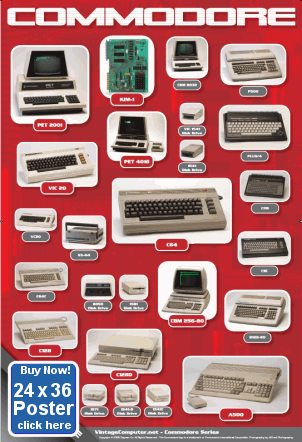
From cover of Radio - Electronics Magazine July 1954.